Understanding the Action of RARγ Agonists on Human Osteochondroma Explants
Abstract
:1. Introduction
2. Results
2.1. Osteochondroma Explant Cultures
2.2. Comparison of Gene Expression Profile between Control and RARγ Agonist Treated Osteochondromas
2.3. RARγ Agonists Induce the Actions for the Destruction of Osteochondroma Cartilage
3. Discussion
4. Materials and Methods
4.1. Human Osteochondroma Specimens
4.2. Chondrocytes from Human polydactyly
4.3. Drug and Drug Treatment
4.4. Histology
4.5. Live/Dead Assay
4.6. RNA isolation and qPCR
4.7. Transcriptome Analysis
Supplementary Materials
Author Contributions
Funding
Acknowledgments
Conflicts of Interest
References
- De Souza, A.M.; Bispo Junior, R.Z. Osteochondroma: Ignore or investigate? Rev. Bras. De Ortop. 2014, 49, 555–564. [Google Scholar] [CrossRef] [Green Version]
- Unni, K.K.; Inwards, C.Y. AFIP Atlas of Tumor Pathology: Tumors of the Bones and Joints, 4th ed.; Armed Forces Institute of Pathology: Washington, DC, USA, 2006. [Google Scholar]
- Bovee, J.V.; Hogendoorn, P.C.; Wunder, J.S.; Alman, B.A. Cartilage tumours and bone development: Molecular pathology and possible therapeutic targets. Nat. Rev. Cancer 2010, 10, 481–488. [Google Scholar] [CrossRef]
- Gelderblom, H.; Hogendoorn, P.C.; Dijkstra, S.D.; van Rijswijk, C.S.; Krol, A.D.; Taminiau, A.H.; Bovee, J.V. The clinical approach towards chondrosarcoma. Oncologist 2008, 13, 320–329. [Google Scholar] [CrossRef] [PubMed]
- Ryckx, A.; Somers, J.F.; Allaert, L. Hereditary multiple exostosis. Acta Orthop. Belg. 2013, 79, 597–607. [Google Scholar]
- Pannier, S.; Legeai-Mallet, L. Hereditary multiple exostoses and enchondromatosis. Best Pract. Res. Clin. Rheumatol. 2008, 22, 45–54. [Google Scholar] [CrossRef] [PubMed]
- Ashraf, A.; Larson, A.N.; Ferski, G.; Mielke, C.H.; Wetjen, N.M.; Guidera, K.J. Spinal stenosis frequent in children with multiple hereditary exostoses. J. Child. Orthop. 2013, 7, 183–194. [Google Scholar] [CrossRef] [Green Version]
- Pelc, H.J.; Walker, J.; Davies, G. Successful operative management of an asymptomatic chest lesion in hereditary multiple exostosis. J. Pediatric Orthop. B 2013, 22, 505–508. [Google Scholar] [CrossRef]
- Lind, T.; Tufaro, F.; McCormick, C.; Lindahl, U.; Lidholt, K. The putative tumor suppressors EXT1 and EXT2 are glycosyltransferases required for the biosynthesis of heparan sulfate. J. Biol. Chem. 1998, 273, 26265–26268. [Google Scholar] [CrossRef] [PubMed] [Green Version]
- McCormick, C.; Leduc, Y.; Martindale, D.; Mattison, K.; Esford, L.E.; Dyer, A.P.; Tufaro, F. The putative tumour suppressor EXT1 alters the expression of cell-surface heparan sulfate. Nat. Genet. 1998, 19, 158–161. [Google Scholar] [CrossRef] [PubMed]
- Simmons, A.D.; Musy, M.M.; Lopes, C.S.; Hwang, L.Y.; Yang, Y.P.; Lovett, M. A direct interaction between EXT proteins and glycosyltransferases is defective in hereditary multiple exostoses. Hum. Mol. Genet. 1999, 8, 2155–2164. [Google Scholar] [CrossRef] [Green Version]
- Williams, J.A.; Kondo, N.; Okabe, T.; Takeshita, N.; Pilchak, D.M.; Koyama, E.; Ochiai, T.; Jensen, D.; Chu, M.L.; Kane, M.A.; et al. Retinoic acid receptors are required for skeletal growth, matrix homeostasis and growth plate function in postnatal mouse. Dev. Biol. 2009, 328, 315–327. [Google Scholar] [CrossRef] [Green Version]
- Koyama, E.; Golden, E.B.; Kirsch, T.; Adams, S.L.; Chandraratna, R.A.; Michaille, J.J.; Pacifici, M. Retinoid signaling is required for chondrocyte maturation and endochondral bone formation during limb skeletogenesis. Dev. Biol. 1999, 208, 375–391. [Google Scholar] [CrossRef] [PubMed] [Green Version]
- Shimono, K.; Tung, W.E.; Macolino, C.; Chi, A.H.; Didizian, J.H.; Mundy, C.; Chandraratna, R.A.; Mishina, Y.; Enomoto-Iwamoto, M.; Pacifici, M.; et al. Potent inhibition of heterotopic ossification by nuclear retinoic acid receptor-gamma agonists. Nat. Med. 2011, 17, 454–460. [Google Scholar] [CrossRef] [Green Version]
- Chakkalakal, S.A.; Uchibe, K.; Convente, M.R.; Zhang, D.; Economides, A.N.; Kaplan, F.S.; Pacifici, M.; Iwamoto, M.; Shore, E.M. Palovarotene Inhibits Heterotopic Ossification and Maintains Limb Mobility and Growth in Mice With the Human ACVR1(R206H) Fibrodysplasia Ossificans Progressiva (FOP) Mutation. J. Bone Miner. Res. 2016, 31, 1666–1675. [Google Scholar] [CrossRef] [Green Version]
- Pavey, G.J.; Qureshi, A.T.; Tomasino, A.M.; Honnold, C.L.; Bishop, D.K.; Agarwal, S.; Loder, S.; Levi, B.; Pacifici, M.; Iwamoto, M.; et al. Targeted stimulation of retinoic acid receptor-gamma mitigates the formation of heterotopic ossification in an established blast-related traumatic injury model. Bone 2016, 90, 159–167. [Google Scholar] [CrossRef] [PubMed] [Green Version]
- Inubushi, T.; Lemire, I.; Irie, F.; Yamaguchi, Y. Palovarotene inhibits osteochondroma formation in a mouse model of multiple hereditary exostoses. J. Bone Miner. Res. 2018, 33, 658–666. [Google Scholar] [CrossRef] [Green Version]
- Huang da, W.; Sherman, B.T.; Lempicki, R.A. Systematic and integrative analysis of large gene lists using DAVID bioinformatics resources. Nat. Protoc. 2009, 4, 44–57. [Google Scholar] [CrossRef]
- Da Huang, W.; Sherman, B.T.; Lempicki, R.A. Bioinformatics enrichment tools: Paths toward the comprehensive functional analysis of large gene lists. Nucleic Acids Res. 2009, 37, 1–13. [Google Scholar] [CrossRef] [PubMed] [Green Version]
- Takigawa, M.; Takano, T.; Suzuki, F. Restoration by cyclic AMP of the differentiated phenotype of chondrocytes from de-differentiated cells pretreated with retinoids. Mol. Cell. Biochem. 1982, 42, 145–153. [Google Scholar] [CrossRef] [PubMed]
- Yasuhara, R.; Yuasa, T.; Williams, J.A.; Byers, S.W.; Shah, S.; Pacifici, M.; Iwamoto, M.; Enomoto-Iwamoto, M. Wnt/beta-catenin and retinoic acid receptor signaling pathways interact to regulate chondrocyte function and matrix turnover. J. Biol. Chem. 2010, 285, 317–327. [Google Scholar] [CrossRef] [Green Version]
- Enomoto, M.; Pan, H.; Suzuki, F.; Takigawa, M. Physiological role of vitamin A in growth cartilage cells: Low concentrations of retinoic acid strongly promote the proliferation of rabbit costal growth cartilage cells in culture. J. Biochem. 1990, 107, 743–748. [Google Scholar] [CrossRef]
- Taniguchi, T.; Ogasawara, K.; Takaoka, A.; Tanaka, N. IRF family of transcription factors as regulators of host defense. Annu. Rev. Immunol. 2001, 19, 623–655. [Google Scholar] [CrossRef] [PubMed]
- Luo, X.M.; Ross, A.C. Retinoic acid exerts dual regulatory actions on the expression and nuclear localization of interferon regulatory factor-1. Exp. Biol. Med. (Maywood) 2006, 231, 619–631. [Google Scholar] [CrossRef] [Green Version]
- Clarke, N.; Jimenez-Lara, A.M.; Voltz, E.; Gronemeyer, H. Tumor suppressor IRF-1 mediates retinoid and interferon anticancer signaling to death ligand TRAIL. EMBO J. 2004, 23, 3051–3060. [Google Scholar] [CrossRef] [Green Version]
- Dou, L.; Liang, H.F.; Geller, D.A.; Chen, Y.F.; Chen, X.P. The regulation role of interferon regulatory factor-1 gene and clinical relevance. Hum. Immunol. 2014, 75, 1110–1114. [Google Scholar] [CrossRef] [PubMed]
- Alsamman, K.; El-Masry, O.S. Interferon regulatory factor 1 inactivation in human cancer. Biosci. Rep. 2018, 38. [Google Scholar] [CrossRef] [PubMed] [Green Version]
- Sun, T.; Gao, F.; Lin, X.; Yu, R.; Zhao, Y.; Luan, J.; Li, H.; Song, M. alpha-Lipoic acid (alpha-LA) inhibits the transcriptional activity of interferon regulatory factor 1 (IRF-1) via SUMOylation. Toxicol. Vitr. 2014, 28, 1242–1248. [Google Scholar] [CrossRef]
- Lu, H.; Zeng, C.; Zhao, H.; Lian, L.; Dai, Y. Glatiramer acetate inhibits degradation of collagen II by suppressing the activity of interferon regulatory factor-1. Biochem. Biophys. Res. Commun. 2014, 448, 323–328. [Google Scholar] [CrossRef]
- Nanus, D.M.; Geng, Y.; Shen, R.; Lai, H.K.; Pfeffer, S.R.; Pfeffer, L.M. Interaction of retinoic acid and interferon in renal cancer cell lines. J. Interferon Cytokine Res. 2000, 20, 787–794. [Google Scholar] [CrossRef]
- Matikainen, S.; Lehtonen, A.; Sareneva, T.; Julkunen, I. Regulation of IRF and STAT gene expression by retinoic acid. Leuk. Lymphoma 1998, 30, 63–71. [Google Scholar] [CrossRef] [PubMed]
- Lees-Shepard, J.B.; Nicholas, S.A.E.; Stoessel, S.J.; Devarakonda, P.M.; Schneider, M.J.; Yamamoto, M.; Goldhamer, D.J. Palovarotene reduces heterotopic ossification in juvenile FOP mice but exhibits pronounced skeletal toxicity. eLife 2018, 7. [Google Scholar] [CrossRef] [PubMed]
- Hind, M.; Stinchcombe, S. Palovarotene, a novel retinoic acid receptor gamma agonist for the treatment of emphysema. Expert Opin. Investig. Drugs 2009, 10, 1243–1250. [Google Scholar]
- Kim, D.; Langmead, B.; Salzberg, S.L. HISAT: A fast spliced aligner with low memory requirements. Nat. Methods 2015, 12, 357–360. [Google Scholar] [CrossRef] [PubMed] [Green Version]
- Anders, S.; Pyl, P.T.; Huber, W. HTSeq—A Python framework to work with high-throughput sequencing data. Bioinformatics 2015, 31, 166–169. [Google Scholar] [CrossRef]
- Robinson, M.D.; McCarthy, D.J.; Smyth, G.K. edgeR: A Bioconductor package for differential expression analysis of digital gene expression data. Bioinformatics 2010, 26, 139–140. [Google Scholar] [CrossRef] [PubMed] [Green Version]
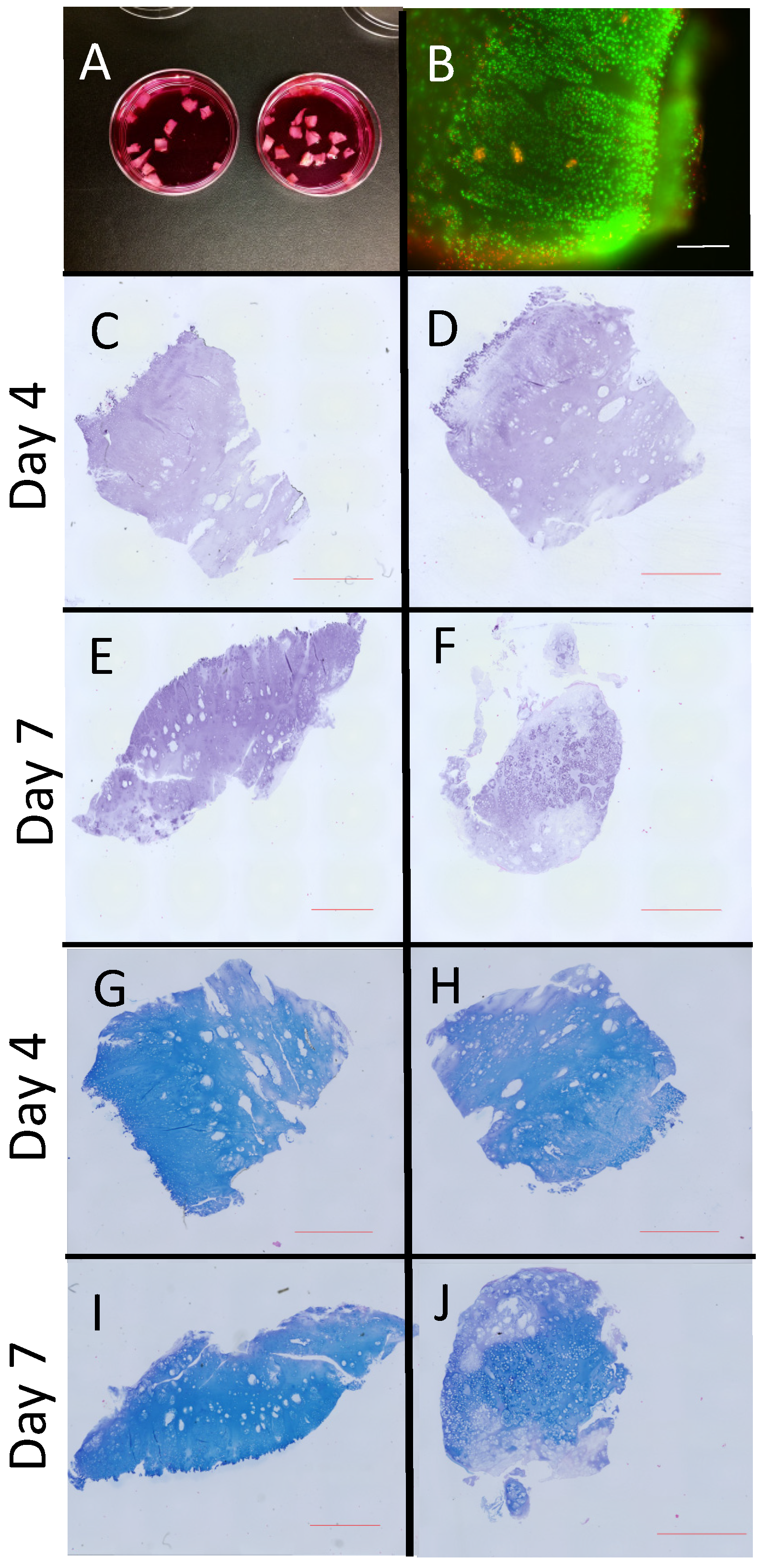
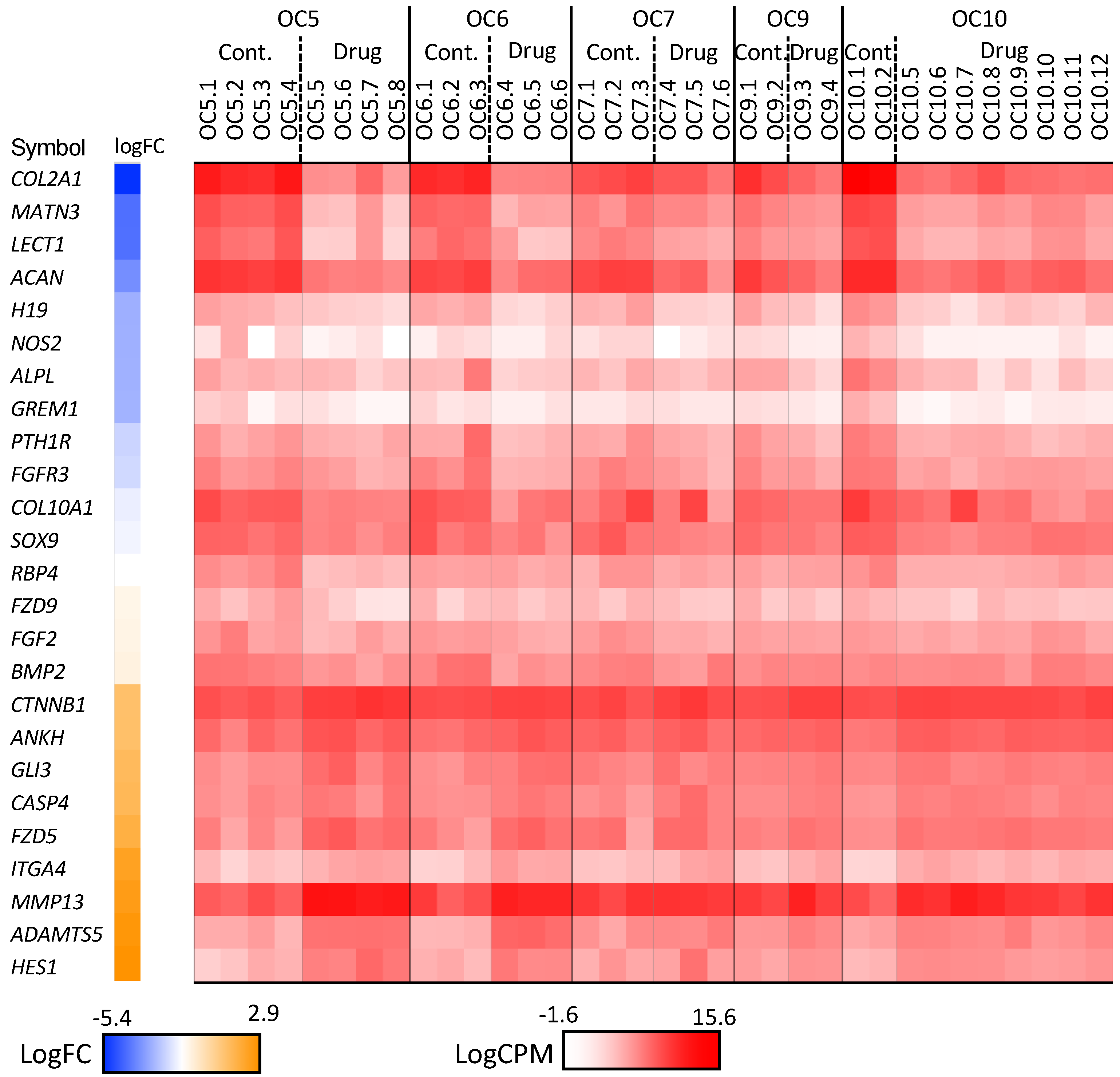
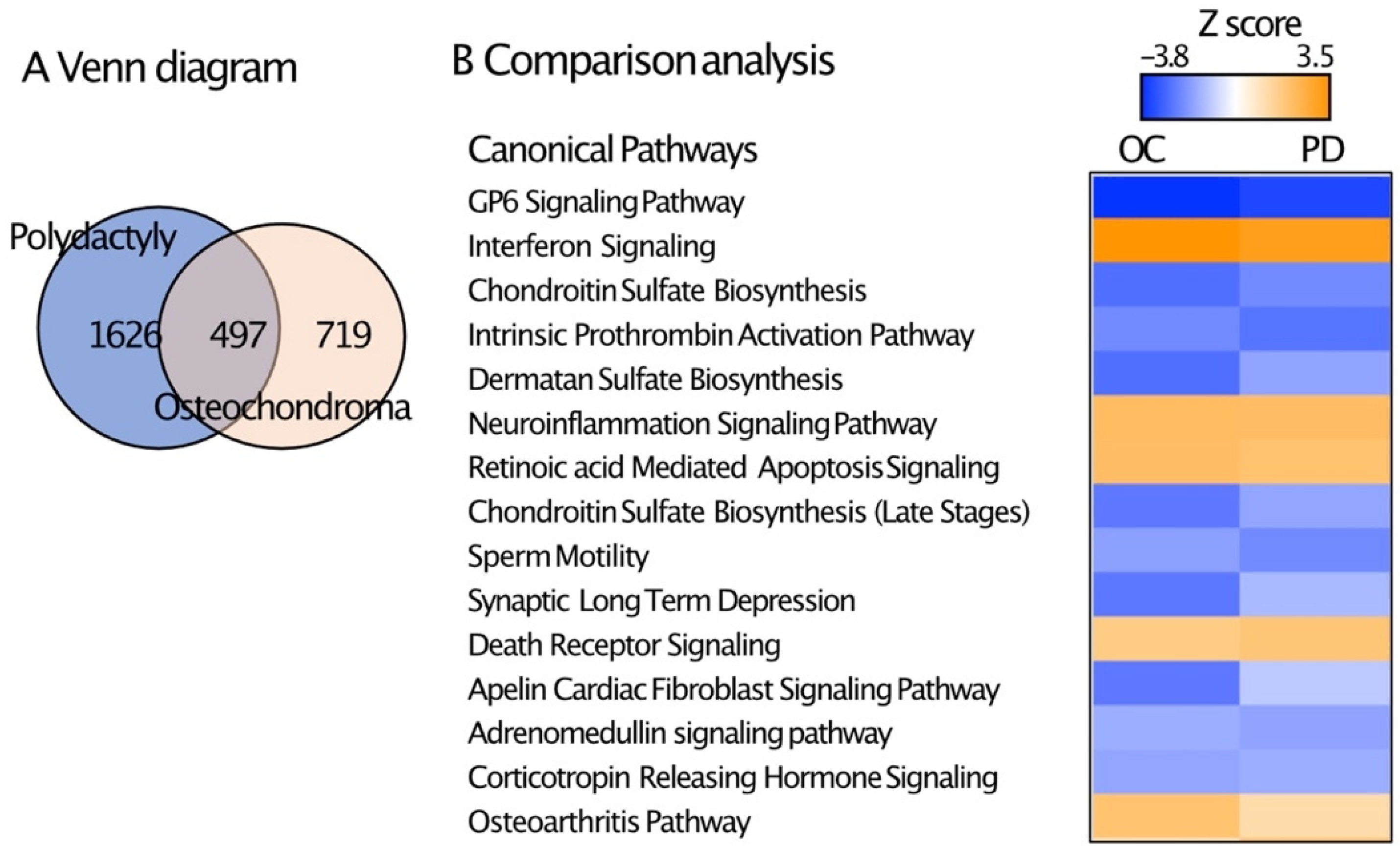
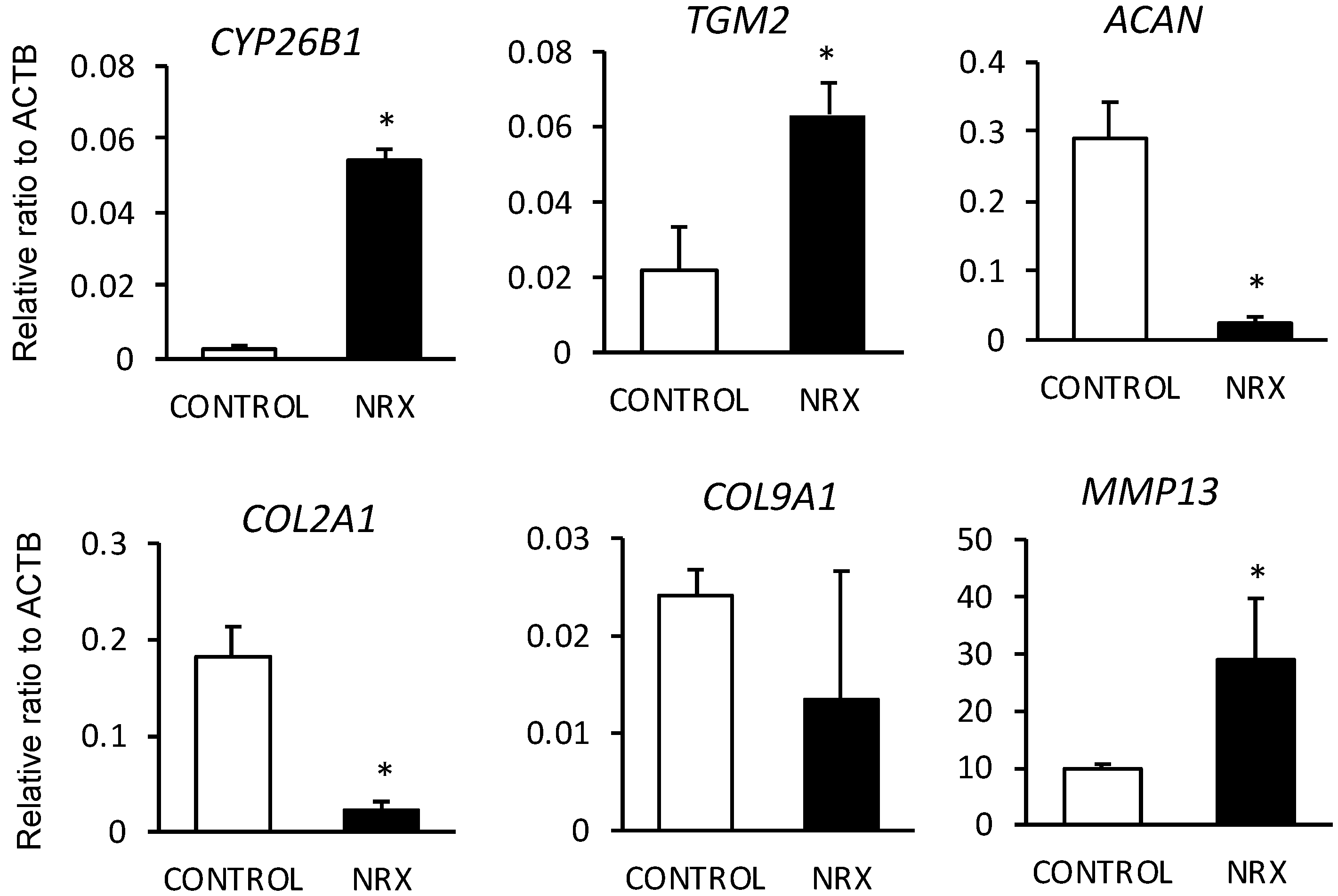
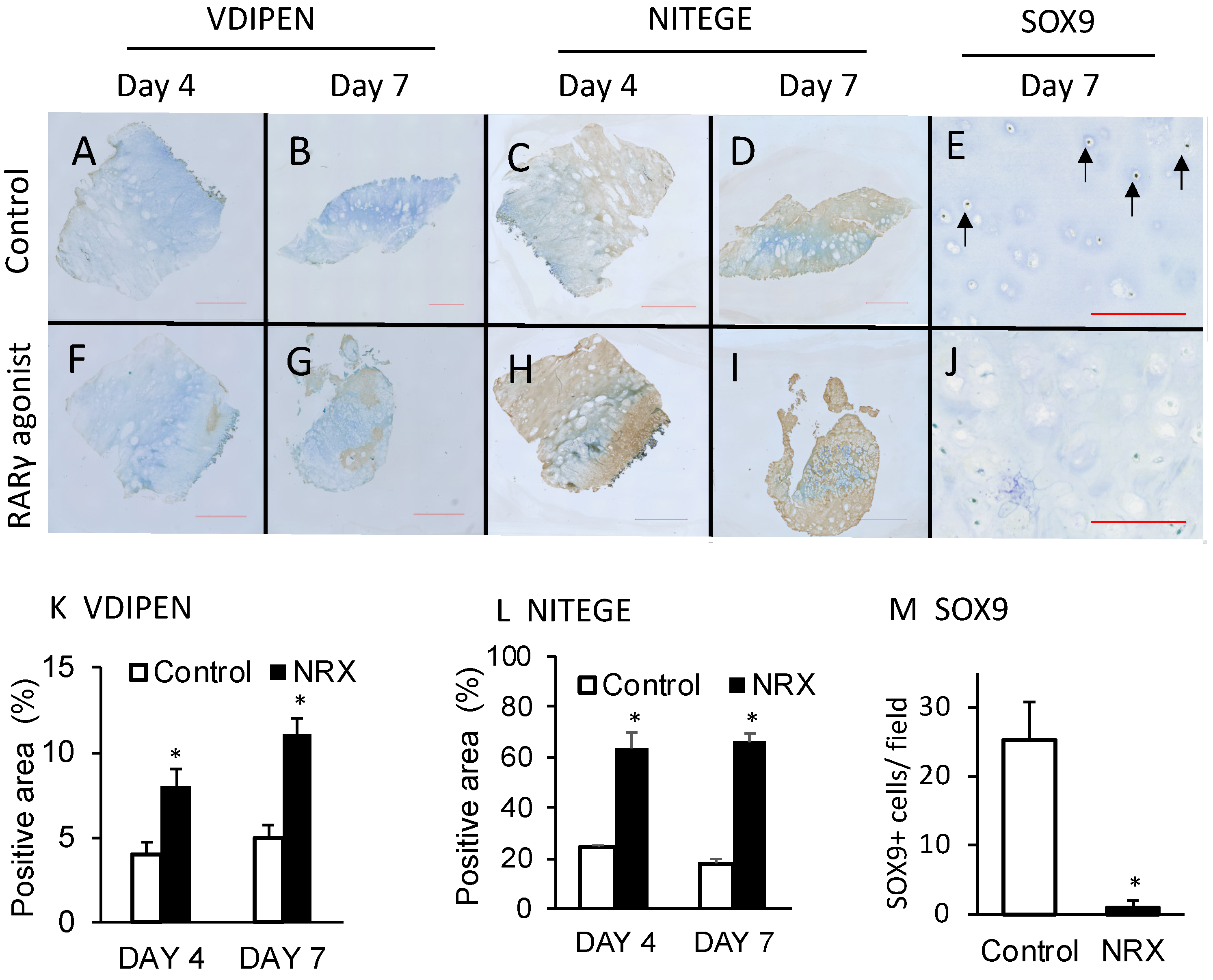

| GO ID | Description | p-Value | Gene |
|---|---|---|---|
| 0030198 | extracellular matrix organization | 2.60 × 10−24 | GFAP, TNC, NPNT, ELN, ITGA11, COL2A1, POSTN, ITGB3, SOX9, ABI3BP, COL9A1, SMOC2, TNFRSF11B, COL9A2, COL9A3, COL7A1, COL27A1, COMP, COL6A3, ACAN, COL6A1, LOX, FGF2, COL8A2, COL11A1, LOXL1, CYR61, COL10A1, ICAM1, HAPLN1, MATN3, MATN4, MATN1, ITGA1, HSPG2, ITGA4, SPARC, COL5A3, COL16A1, NDNF, COL5A1, CSGALNACT1, COL14A1, BGN, COL19A1, ITGA6, LAMC3, COL1A2, COL1A1 |
| 0001501 | skeletal system development | 6.50 × 10−16 | ALPL, NOG, FGFR3, PTH1R, SOX4, POSTN, COL2A1, EXTL1, SOX9, COL9A2, TNFRSF11B, LECT1, COMP, ACAN, COL12A1, COL11A2, PAPSS2, COL10A1, MATN3, HAPLN1, BMP2, CMKLR1, IGF2, ANKH, EPHA2, PRELP, SHOX2, COL19A1, CLEC3A, ETS2, COL1A2, FOXC1, COL1A1 |
| 0030199 | collagen fibril organization | 8.49 × 10−13 | FMOD, ADAMTS14, COL2A1, COL5A3, GREM1, SERPINH1, COL5A1, COL14A1, SFRP2, ACAN, COL1A2, COL12A1, FOXC1, COL1A1, LOX, COL11A2, COL11A1 |
| 0007155 | cell adhesion | 3.01 × 10−11 | NRP2, MYBPC1, IGFBP7, POSTN, CTNNB1, WISP2, CGREF1, S1PR1, SRPX, WISP3, COL12A1, BOC, CYR61, ICAM1, TYRO3, ACKR3, CTNNA3, HES1, AMBP, LAMC3, CX3CR1, COL1A1, MFAP4, TNC, ITGA11, CTNND2, ITGB3, CX3CL1, ISLR, LPXN, COL7A1, COMP, COL6A3, ACAN, PSTPIP1, COL6A1, CD24, THBS2, THBS3, HAPLN1, FLRT1, COL15A1, ITGA4, COL16A1, TINAGL1, COL5A1, CDH13, COL19A1, CDH15, ITGA6, DSG2, ENG, MYH10 |
| 0030574 | collagen catabolic process | 4.94 × 10−10 | ADAMTS14, COL15A1, COL2A1, MMP16, COL5A3, MMP13, COL5A1, COL19A1, COL7A1, COL6A3, COL1A2, COL12A1, COL6A1, COL1A1, COL11A2, COL8A2, COL11A1, COL10A1 |
| 0060337 | type I interferon signaling pathway | 4.22 × 10−9 | BST2, IFITM1, IFITM3, OAS3, OAS1, OAS2, IFI35, STAT2, IFIT3, IFIT2, OASL, ISG15, IRF1, IRF2, MX1, GBP2, IFI6 |
| Pathways | −log (p-Value) | Ratio | Gene |
|---|---|---|---|
| Hepatic Fibrosis/Hepatic Stellate Cell Activation | 14.9 | 0.183 | A2M, ACTA2, COL10A1, COL11A1, COL11A2, COL12A1, COL15A1, COL16A1, COL19A1, COL1A1, COL1A2, COL21A1, COL27A1, COL2A1, COL5A1, COL5A3, COL6A1, COL6A3, COL7A1, COL8A2, COL9A1, COL9A2, COL9A3, CSF1, FGF2, ICAM1, IGF1R, IGF2, IL10, LBP, MMP13, M H10, TIMP1, TNFRSF11B |
| GP6 Signaling Pathway | 13.4 | 0.218 | COL10A1, COL11A1, COL11A2, COL12A1, COL15A1, COL16A1, COL19A1, COL1A1, COL1A2, COL21A1, COL27A1, COL2A1, COL5A1, COL5A3, COL6A1, COL6A3, COL7A1, COL8A2, COL9A1, COL9A2, COL9A3, ITGB3, LAMC3, PRKCH, PRKCZ, SCHIP1 |
| Atherosclerosis Signaling | 7.91 | 0.159 | ALOX15, APOL1, COL10A1, COL11A2, COL1A1, COL1A2, COL2A1, COL5A3, CSF1, ICAM1, ITGA4, MMP13, PLA2G12A, PLA2G3, PLA2G5, PLAAT3, PLAAT4, PNPLA3, RBP4, SERPINA1 |
| Osteoarthritis Pathway | 7.07 | 0.118 | ACAN, ADAMTS5, ALPL, ANKH, BMP2, CASP4, CNMD, COL10A1, COL2A1, CTNNB1, FGF2, FGFR3, FZD5, FZD9, GLI3, GREM1, H19, HES1, ITGA4, MATN3, MMP13, NOS2, PTH1R, RBP4, SOX9 |
| Interferon Signaling | 6.59 | 0.278 | IFI35, IFI6, IFIT3, IFITM1, IFITM3, IRF1, ISG15, MX1, OAS1, STAT2 |
| Pathways | −log (p-Value) | Ratio | Molecules |
|---|---|---|---|
| Hepatic Fibrosis/Hepatic Stellate Cell Activation | 10.7 | 0.231 | A2M, AGTR1, CCL2, CCN2, CD14, COL11A1, COL16A1, COL17A1, COL1A1, COL21A1, COL23A1, COL27A1, COL2A1, COL4A3, COL4A5, COL4A6, COL5A1, COL5A3, COL6A1, COL6A6, COL9A1, COL9A2, COL9A3, CSF1, CXCL8, HGF, IGF1, IGF2, IL1B, IL1R2, IL1RL1, IL1RL2, LBP, LY96, MET, MMP1, MMP13, MYH14, TGFB2, TIMP1, TLR4, TNFRSF11B, VEGFD |
| Atherosclerosis Signaling | 8.18 | 0.242 | ALOX12B, ALOX15B, ALOXE3, APOD, APOL1, CCL2, CLU, COL1A1, COL2A1, COL5A3, CSF1, CXCL8, IL18, IL1B, IL36G, IL36RN, ITGA4, LPL, MMP1, MMP13, PLA2G2A, PLA2G3, PLA2G4D, PLA2G4E, PLA2G4F, PLAAT3, PLAAT4, RBP4, S100A8, SELP |
| Osteoarthritis Pathway | 0.774 | 0.192 | ACAN, ADAMTS5, ALPL, CASP14, CASP4, CNMD, COL2A1, CTNNB1, CXCL8, DKK1, ELF3, FGF18, FGFR3, FRZB, FZD5, FZD9, GDF5, H19, HES1, IHH, IL1B, IL1R2, IL1RL1, IL1RL, ITGA4, MATN3, mir-140, MMP1, MMP13, NOS2, PPARGC1A, PRKAG2, PTHLH, RARRES2, RBP4, S100A8, S100A9, SERPINA12, SOX9, TLR4, VEGFD |
| LPS/IL-1 Mediated Inhibition of RXR Function | 0.710 | 0.183 | ABCB1, ABCG1, ACSL5, ALDH1A1, ALDH1L1, ALDH1L2, ALDH3A1, ALDH3B2, CD14, CHST3, CPT1A, CYP3A5, FABP5, FABP7, FMO1, FMO2, FMO4, GSTO2, HS3ST1, HS3ST3A1, HS6ST2, IL18, IL1B, IL1R2, IL1RL1, IL1RL2, IL36G, IL36RN, IL4I1, LBP, LY96, MAOB, NR1H3, PAPSS2, PPARGC1, SCARB1, SLC27A2, SMOX, SULT2B1, TLR4, TNFRSF11B |
| Role of Osteoblasts, Osteoclasts and Chondrocytes in Rheumatoid Arthritis | 0.681 | 0.181 | ADAMTS5, ALPL, APC2, BMP10, BMP3, BMP4, BMP6, BMP7, CALML5, CAMK4, COL1A1, CSF1, CTNNB1, DKK1, FOS, FRZB, FZD5, FZD9, IGF1, IL18, IL1B, IL1R2, IL1RL1, IL1RL2, IL36G, IL36RN, ITGB3, MAP2K6, MAP3K5, MMP1, MMP13, SFRP2, SFRP4, SFRP5, TNFRSF11B, TNFSF11, WNT10A, WNT2B, WNT4, WNT7A |
© 2020 by the authors. Licensee MDPI, Basel, Switzerland. This article is an open access article distributed under the terms and conditions of the Creative Commons Attribution (CC BY) license (http://creativecommons.org/licenses/by/4.0/).
Share and Cite
Garcia, S.A.; Tian, H.; Imamura-Kawasawa, Y.; Fisher, A.; Cellini, A.; Codd, C.; Herzenberg, J.E.; Abzug, J.M.; Ng, V.; Iwamoto, M.; et al. Understanding the Action of RARγ Agonists on Human Osteochondroma Explants. Int. J. Mol. Sci. 2020, 21, 2686. https://doi.org/10.3390/ijms21082686
Garcia SA, Tian H, Imamura-Kawasawa Y, Fisher A, Cellini A, Codd C, Herzenberg JE, Abzug JM, Ng V, Iwamoto M, et al. Understanding the Action of RARγ Agonists on Human Osteochondroma Explants. International Journal of Molecular Sciences. 2020; 21(8):2686. https://doi.org/10.3390/ijms21082686
Chicago/Turabian StyleGarcia, Sonia A., Hongying Tian, Yuka Imamura-Kawasawa, Aidan Fisher, Ashley Cellini, Casey Codd, John E. Herzenberg, Joshua M. Abzug, Vincent Ng, Masahiro Iwamoto, and et al. 2020. "Understanding the Action of RARγ Agonists on Human Osteochondroma Explants" International Journal of Molecular Sciences 21, no. 8: 2686. https://doi.org/10.3390/ijms21082686
APA StyleGarcia, S. A., Tian, H., Imamura-Kawasawa, Y., Fisher, A., Cellini, A., Codd, C., Herzenberg, J. E., Abzug, J. M., Ng, V., Iwamoto, M., & Enomoto-Iwamoto, M. (2020). Understanding the Action of RARγ Agonists on Human Osteochondroma Explants. International Journal of Molecular Sciences, 21(8), 2686. https://doi.org/10.3390/ijms21082686






